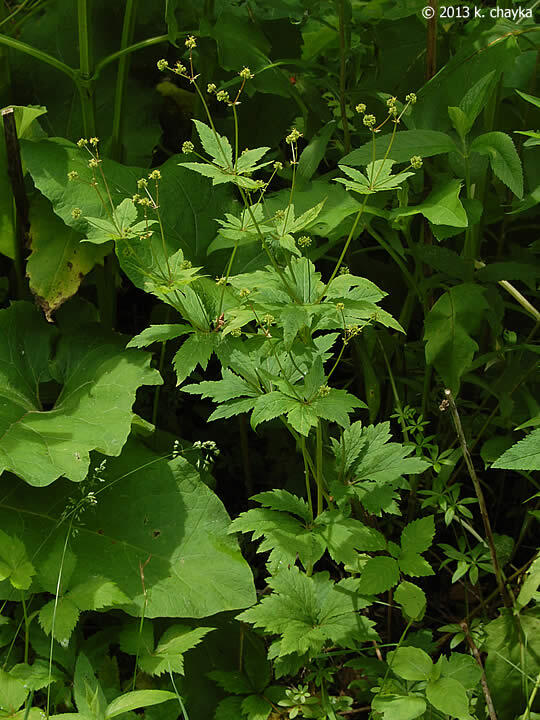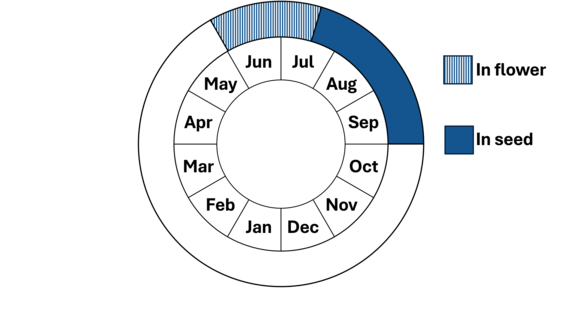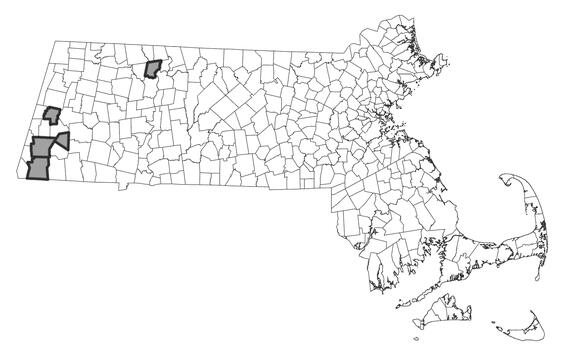- Scientific name: Sanicula odorata (Raf.) Pryer & Phillippe
- Synonymy: Sanicula gregaria E.P. Bicknell
- Species of Greatest Conservation Need (MA State Wildlife Action Plan)
- Threatened (MA Endangered Species Act)
Description

Photograph by Katy Chayka, MinnesotaWildflower.info
Clustered sanicle (Sanicula odorata) is a perennial wildflower of the parsley family (Apiaceae) that inhabits rich, often alluvial woodlands. It is a glabrous (hairless), sometimes branching plant, 30-75 cm (1-2.5 ft) in height, with toothed, palmately-compound leaves and tiny fragrant flowers borne in a compound umbel inflorescence. The distinctive fruit has hooked bristles, which enable dispersal by clinging to passing animals (ectozoochory); this transport can result in a dynamic patchy distribution of plants within a habitat.
The basal leaves usually have five leaflets, often with each incised to form two to three lobes, and the petioles that are longer than the blade. The stem (cauline) leaves usually have three leaflets and are sessile and smaller higher on the stem. The small flowers are five-lobed and yellowish-green, borne on umbellets, the ultimate clusters of a compound umbel; umbellets of clustered sanicle are either polygamous (comprising both hermaphroditic and staminate flowers), or are entirely staminate. The polygamous umbel is a triad of three hermaphroditic flowers (i.e., with both pistils and stamens), each on a short pedicel (≤1mm), over-topped by 12+ staminate flowers with longer pedicels. The hermaphroditic flowers and subsequent fruits are globose, and bur-like, armed with hooked bristles. The two-seeded fruits are up to 6 mm (0.2 in) long and have persistent equilateral triangular, blunt-tipped sepals, two recurved protruding styles, and (unlike other local sanicles) have bristles that do not expand at the base. Clustered sanicle flowers in early summer; fruits mature by late summer and may not persist on the plant later in the season.
| Sanicle Species | Calyx | Bristles | Styles | Umbellets |
|---|---|---|---|---|
| Clustered sanicle, S. odorata | Triangular, blunt, shorter than bristles | Not conspicuously expanded at base | Recurved, much protruding beyond calyx | Staminate and polygamous |
| Trefoil sanicle, S. trifoliata | Lanceolate, sharply tipped exceeding bristles | Expanded at base | Not protruding beyond calyx | Only polygamous |
| Canadian sanicle, S. canadensis | Lanceolate, sharply tipped, concealed by bristles | Expanded at base | Not protruding beyond calyx | Only polygamous |
| Black snakeroot, S. marilandica | Long, pointed; inconspicuous among bristles | Expanded at base | Recurved, much protruding beyond calyx | Staminate and polygamous |
Clustered sanicle has three congeners in Massachusetts with similar foliage and habitat associations; these include trefoil sanicle (S. trifoliata; watch list, SGCN), Canadian sanicle (S. canadensis; Threatened), and black snakeroot (S. marilandica), a more common species. A technical guide (e.g., Pryer and Phillippe 1989) and a hand lens are required to differentiate among them. The three other sanicles have more sharply-pointed, lanceolate calyx lobes, white-greenish flowers, and bristles that are conspicuously expanded at the base. The best way to ensure correct identification is to examine the plants when the mature fruit is present. Key characteristics include calyx, bristle, and style morphology, their relative lengths, and umbellet composition. Note that persistent filaments with absent anthers may be mistaken for styles, but the filaments are thicker and lighter colored. Honewort (Cryptotaenia canadensis) has foliage similar to sanicles but is readily differentiated when the inflorescence forms. Most other species in the parsley family of similar habitats, including sweet cicely (Osmorhiza spp.) and golden alexanders (Zizia aurea), have pinnately compound leaves.
Lower stem leaves. Photograph by Charley Eiseman.
Mature flowering head showing long style. Photograph by Charley Eiseman.
Life cycle and behavior
Clustered sanicle is perennial. Its seed matures and starts to disperse at the end of August and lasts through September.

Population status
Clustered sanicle is listed under the Massachusetts Endangered Species Act as threatened. All listed species are protected from killing, collecting, possessing, or sale and from activities that would destroy habitat and thus directly or indirectly cause mortality or disrupt critical behaviors. Clustered sanicle is currently known 9 occurrences that have been verified since 1999 in Berkshire and Franklin Counties. Four of its current populations are doing well with many plants present. It is historically known from Hampshire, Essex, and Suffolk Counties.

Distribution in Massachusetts
1999-2024
Based on records in the Natural Heritage Database
Distribution and abundance
Clustered sanicle is known from much of eastern and central North America, from Nova Scotia west to Ontario, and North Dakota south to the Gulf states. It is of conservation concern in its northeastern extent: it is possibly extirpated from Maine, critically imperiled in New Hampshire and Nova Scotia, and imperiled in Massachusetts, Vermont and New Brunswick. Neither Connecticut nor Rhode Island have a state rank for clustered sanicle. It is also possibly extirpated from North Dakota.
Habitat
Clustered sanicle occupies neutral to circumneutral, limestone-influenced soils of shaded, low woodlands and rich mesic forests. Habitats are often associated with rivers or streams, such as alluvial woodlands or high floodplain terraces. Within rich mesic forests, canopy associates include sugar maple (Acer saccharum), white ash (Fraxinus americana), and basswood (Tilia americana); within floodplains the canopy may include ironwood (Carpinus caroliniana), American elm (Ulmus americana), sycamore (Platanus occidentalis), and cottonwood (Populus deltoides). Understory associates are diverse and include rich site indicators, such as Goldie's fern (Dryopteris goldiana; watch list), glade fern (Diplazium pycnocarpon; watch list), trefoil sanicle (Sanicula trifoliata; watch list), maidenhair fern (Adiantum pedatum), American ginseng (Panax quinquefolius; Special Concern), and wild leek (Allium tricoccum).
Healthy habitats are vital for supporting native wildlife and plants. Explore habitats and learn about conservation and restoration in Massachusetts.
Threats
The most commonly noted threat to clustered sanicle populations in Massachusetts is the invasion of exotic plants such as Japanese barberry (Berberis thunbergii), garlic mustard (Alliaria petiolata), and Japanese knotweed (Fallopia japonica); other exotics of rich forests include moneywort (Lysimachia nummularia), goutweed (Aegopodium podagraria), and common buckthorn (Rhamnus carthartica). Land conversion is another threat; dramatic changes in habitat, like extensive canopy removal, can change light conditions, disturb soil, and introduce invasive exotic plants to habitat. Lastly, there are threats related to recreation; trail maintenance, foot and mountain bike traffic, or off-road vehicle use can inadvertently cause physical damage to rare plants.
Conservation
Survey and monitoring
Clustered sanicle prefers habitats with rich, slightly damp soils, which is prime habitat for many invasive plants species. To prevent the populations from being overtaken by invasive plants, it is important to regularly survey and monitor the population, and if populations are threatened to report that. The best time to survey this population is in the late summer or fall in August and September when the fruits are mature and still attached to the plants. Each plant is a separate genet.
Management
As with many rare species, the exact management needs of clustered sanicle are not known. Known habitat locations should be protected from dramatic changes in light or moisture conditions. Sites should be monitored for invasions of exotic plants; if exotic plants are crowding and out-competing this species, a plan should be developed to remove the invaders. Rare plant locations that receive heavy recreational use should be carefully monitored for plant damage or soil disturbance; trails can sometimes be re-routed to protect the population. All active management of rare plant populations (including invasive species removal) is subject to review under the Massachusetts Endangered Species Act and should be planned in close consultation with the Natural Heritage & Endangered Species Program.
Research needs
Given that the entire northeastern extent of clustered sanicle has been ranked of conservation concern, there may be a cause related to changing climate that is not apparent. More research is clearly needed on this species and how climate change may impact it.
References
Gleason, Henry A., and Arthur Cronquist. Manual of Vascular Plants of Northeastern United States and Adjacent Canada, Second Edition. Bronx, NY: The New York Botanical Garden, 1991.
Haines, A. 2011. Flora Novae Angliae – a Manual for the Identification of Native and Naturalized Higher Vascular Plants of New England. New England Wildflower Society, Yale Univ. Press, New Haven, CT.
Hawkins, T. S., J. M. Baskin, and C. C. Baskin. 2007. Seed morphology, germination phenology, and capacity to form a seed bank in six herbaceous layer Apiaceae species of the eastern deciduous forest. Castanea 72(1):8-14.
Johnson, Elizabeth A. 2023. Sanicula trifoliata Rare Plant Profile. New Jersey Department of Environmental Protection, State Parks, Forests & Historic Sites, State Forest Fire Service & Forestry, Office of Natural Lands Management, New Jersey Natural Heritage Program, Trenton, NJ. 14 pp.
NatureServe. 2025. NatureServe Network Biodiversity Location Data accessed through NatureServe Explorer [web application]. NatureServe, Arlington, Virginia. Available https://explorer.natureserve.org/. Accessed: 4/11/2025.
POWO (2025). Plants of the World Online. Facilitated by the Royal Botanic Gardens, Kew. Published on the Internet; https://powo.science.kew.org/ Accessed: 4/11/2025.
Seymour, Frank C. 1969. The Flora of New England, First edition. Charles E. Tuttle Company, Inc. Tokyo, Japan.
Staudinger, M.D., A.V. Karmalkar, K. Terwilliger, K. Burgio, A. Lubeck, H. Higgins, T. Rice, T.L. Morelli, A. D'Amato. 2024. A regional synthesis of climate data to inform the 2025 State Wildlife Action Plans in the Northeast U.S. DOI Northeast Climate Adaptation Science Center Cooperator Report. 406 p. https://doi.org/10.21429/t352-9q86
Contact
| Date published: | May 9, 2025 |
|---|